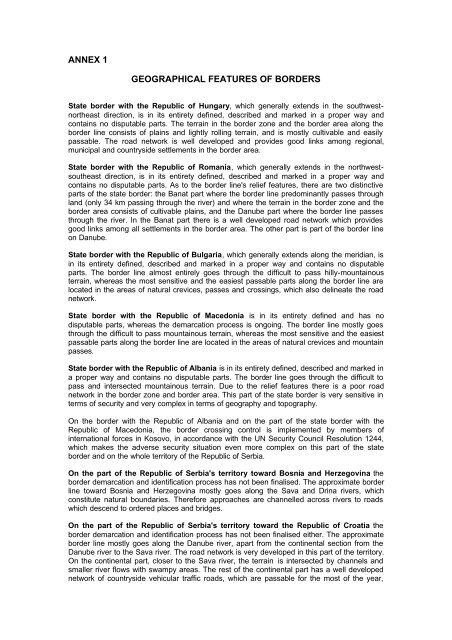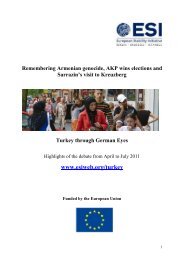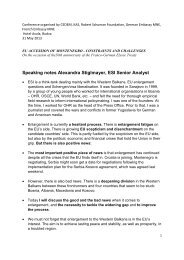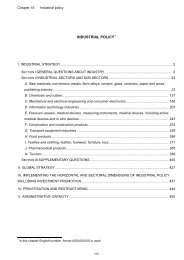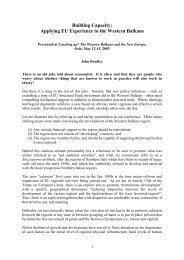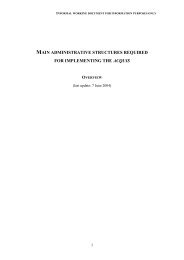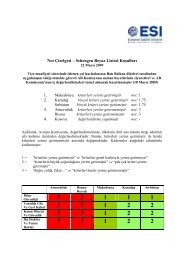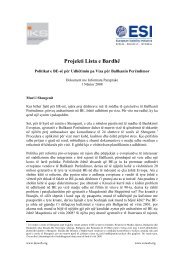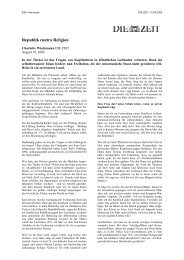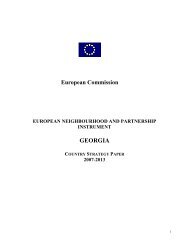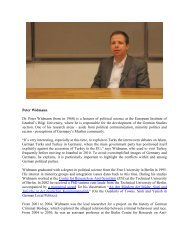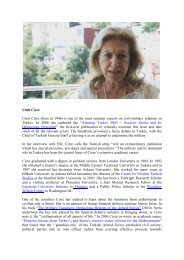Strategy for integrated border management
Strategy for integrated border management
Strategy for integrated border management
You also want an ePaper? Increase the reach of your titles
YUMPU automatically turns print PDFs into web optimized ePapers that Google loves.
ANNEX 1<br />
GEOGRAPHICAL FEATURES OF BORDERS<br />
State <strong>border</strong> with the Republic of Hungary, which generally extends in the southwestnortheast<br />
direction, is in its entirety defined, described and marked in a proper way and<br />
contains no disputable parts. The terrain in the <strong>border</strong> zone and the <strong>border</strong> area along the<br />
<strong>border</strong> line consists of plains and lightly rolling terrain, and is mostly cultivable and easily<br />
passable. The road network is well developed and provides good links among regional,<br />
municipal and countryside settlements in the <strong>border</strong> area.<br />
State <strong>border</strong> with the Republic of Romania, which generally extends in the northwestsoutheast<br />
direction, is in its entirety defined, described and marked in a proper way and<br />
contains no disputable parts. As to the <strong>border</strong> line's relief features, there are two distinctive<br />
parts of the state <strong>border</strong>: the Banat part where the <strong>border</strong> line predominantly passes through<br />
land (only 34 km passing through the river) and where the terrain in the <strong>border</strong> zone and the<br />
<strong>border</strong> area consists of cultivable plains, and the Danube part where the <strong>border</strong> line passes<br />
through the river. In the Banat part there is a well developed road network which provides<br />
good links among all settlements in the <strong>border</strong> area. The other part is part of the <strong>border</strong> line<br />
on Danube.<br />
State <strong>border</strong> with the Republic of Bulgaria, which generally extends along the meridian, is<br />
in its entirety defined, described and marked in a proper way and contains no disputable<br />
parts. The <strong>border</strong> line almost entirely goes through the difficult to pass hilly-mountainous<br />
terrain, whereas the most sensitive and the easiest passable parts along the <strong>border</strong> line are<br />
located in the areas of natural crevices, passes and crossings, which also delineate the road<br />
network.<br />
State <strong>border</strong> with the Republic of Macedonia is in its entirety defined and has no<br />
disputable parts, whereas the demarcation process is ongoing. The <strong>border</strong> line mostly goes<br />
through the difficult to pass mountainous terrain, whereas the most sensitive and the easiest<br />
passable parts along the <strong>border</strong> line are located in the areas of natural crevices and mountain<br />
passes.<br />
State <strong>border</strong> with the Republic of Albania is in its entirety defined, described and marked in<br />
a proper way and contains no disputable parts. The <strong>border</strong> line goes through the difficult to<br />
pass and intersected mountainous terrain. Due to the relief features there is a poor road<br />
network in the <strong>border</strong> zone and <strong>border</strong> area. This part of the state <strong>border</strong> is very sensitive in<br />
terms of security and very complex in terms of geography and topography.<br />
On the <strong>border</strong> with the Republic of Albania and on the part of the state <strong>border</strong> with the<br />
Republic of Macedonia, the <strong>border</strong> crossing control is implemented by members of<br />
international <strong>for</strong>ces in Kosovo, in accordance with the UN Security Council Resolution 1244,<br />
which makes the adverse security situation even more complex on this part of the state<br />
<strong>border</strong> and on the whole territory of the Republic of Serbia.<br />
On the part of the Republic of Serbia's territory toward Bosnia and Herzegovina the<br />
<strong>border</strong> demarcation and identification process has not been finalised. The approximate <strong>border</strong><br />
line toward Bosnia and Herzegovina mostly goes along the Sava and Drina rivers, which<br />
constitute natural boundaries. There<strong>for</strong>e approaches are channelled across rivers to roads<br />
which descend to ordered places and bridges.<br />
On the part of the Republic of Serbia's territory toward the Republic of Croatia the<br />
<strong>border</strong> demarcation and identification process has not been finalised either. The approximate<br />
<strong>border</strong> line mostly goes along the Danube river, apart from the continental section from the<br />
Danube river to the Sava river. The road network is very developed in this part of the territory.<br />
On the continental part, closer to the Sava river, the terrain is intersected by channels and<br />
smaller river flows with swampy areas. The rest of the continental part has a well developed<br />
network of countryside vehicular traffic roads, which are passable <strong>for</strong> the most of the year,


